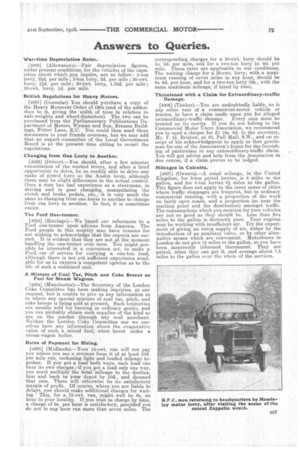Answers to Queries.
Page 17

If you've noticed an error in this article please click here to report it so we can fix it.
Wartime Depreciation Rates.
[40001 (Allowances).—Fair depreciation figures, under present conditions, for the vehicles of the capacities about which you inquire, are as follow: 5-ton lorry, 21d. per mile ; 3-ton lorry, 2d. per mile ; 30-cwt. lorry, lid. per mile ; 20-owt. lorry, 1.33d. per mile ; 10-cwt. lorry, id. per mile.
British Regulations for Heavy Motors.
[4001] (Consular) You should purchase a copy of the Heavy Motorcar Order of 1904 (and of the addendum to it, giving the width of tires in relation to axle-weights and wheel-diameters). The two can be purchased from the Parliamentary Publications Department of Messrs. Wyman and Son, Breams Buildings, Fetter Lane, E.C. You could then send these documents to your friends overseas, but we may add that an expert committee of the Local Government Board is at the present time sitting to recast the regulations.
Changing from One Lorry to Another.
[4002] (Driver).—You should, after a few minutes examination of the control levers, and after a brief opportunity to drive, be as readily able to drive any make of petrol lorry as the Austin lorry, although there may be Blight differences in the actual control. Once a man has had experience as a steersman, in driving and in gear cha,nging, manipulating the clutch and brake pedals, etc., it is very much the same as changing from one horse to another to change from one lorry to another, In fact., it is sometimes easier
The Ford One.tonner.
[4003] (Haulage).---We based our references to a Ford one-tonner upon advices from America. The Ford people in this country may have reasons for not wishing to acknowledge that the reports are correct It is evident that they are not at the moment handling the one-tonner over here. You might possibly be interested in a conversion set, to make a Ford car of service for carrying a one-ton load, although there is not yet sufficient experience available for us to express a competent opinion as to the life of such a combined unit.
A Mixture of Coal Tar, Pitch and Coke Breeze as Fuel for Steam Wagons. .
[4004] (Manchester).—The Secretary of the London Coke Committee has been making inquiries, at our request, but is unable to give us any information as to where any special mixture of coal tar, pitch, and coke breeze is being sold at present. Such briquettes are usually sold for burning in ordinary grates, and you can probably obtain such supplies of the kind as are on the market through any coal merehant Neither the London Coke Committee nor we ourselves have any information about the evaporative value of such. a mixed fuel, when burnt under a steam-wagon boiler.
Rates of Payment for Hiring.
[4005] (Midlands).—Your 15-cwt. van will not pay you unless you see a revenue from it of at least 10d. per mile run, reckoning light and loaded mileage together. If you get a load both ways, each load can bear its own charges ;if you get a load only one way, you must multiply the total mileage to the destination and back to ycsie depot by 10d., and demand that sum. There will otherwise be no satisfactory margin of profit. Of course, where you are liable to delays, you should make additional charges for waiting. ' This, for a 15-cwt. van, might well be 6s. an hour in your locality. If you wish to charge by time, a charge of 6s. per hour is satisfactory, pros,ided you do not in any hour run more than seven miles. The corresponding. charges for a 30-cwt. lorry should be is. 3d. per mile, and for a two-ton lorry is. 6d. per mile. These rates are applicable to war conditions. The waiting charge for a 30-ewt. lorry, with a maximum running of seven miles in any hour, should be 8s. 6d. per hour, and for a two-ton lorry 10S., with the same maximum mileage, if hired by time.
Threatened with a Claim for Extraordinary-traffic Damage.
, [4006] (Timber).—You are undoubtedly liable, as is any other user of a commercial-motor vehicle or tractor, to have a claim made upon you for .alleged
extraordinary-traffic damage, livery case must, be treated on its merits. If you de not belong to the Commercial Motor Users Association, we recommend you to seed a cheque for £116s. 9d. to the secretary, Ms. F, G. Bristow, at 83, Pall Mall, S.W., and on receipt of his acknowledgment to apply to that gentleman for one of the Association's forms for the furnishing of particulars re any extraordinary-traffic claim. You will get advice and help from the Association in due course, if a claim proves to be lodged.
Mileages in Calcutta.
WO] (Owners).—A usual mileage, in the United Kingdom, for 3-ton petrol lorries, is 8 miles to the
gallon and f.or 4-ton lorries miles to the gallon. This gallon, does not apply to the inner zones of cities
where traffic stoppages are frequent, but to ordinary commercial running, with a proportion of the work on fairly open roads, and a proportion (as near the starting point and the destination) amongst traffic. The consumptions which you mention for your vehicles are not so good as they should be. Less than five miles to the gallon is distinctly poor. Your engines may be working with insufficient air. Try the experiment of giving an extra supply of air, either by the introduction of an auxiliary valve, or by other alternative means which are convenient. Motorbuses in London do not give 12 miles to the gallon, so you have been incorrectly informed thereanent. They use ,petrol, when they can get it, and average about 7.5 miles to the gallon over the whole of the services.




















